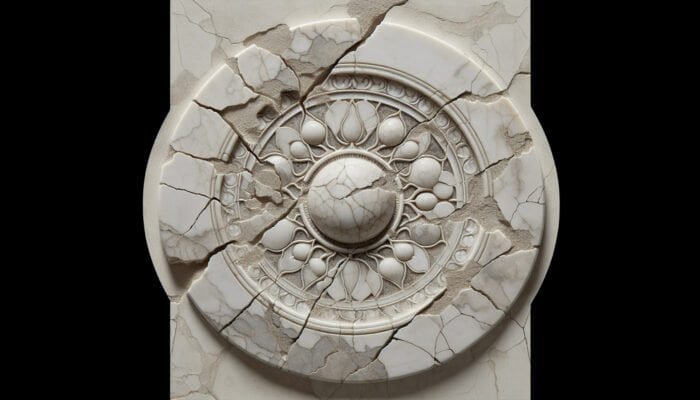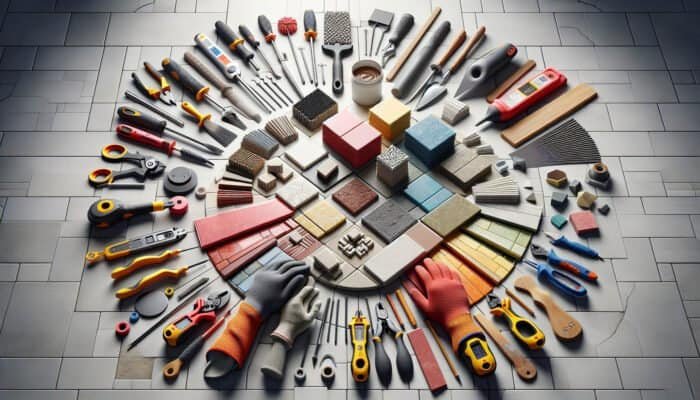


July 23, 2025 by
David Allen

Porcelain tiles, while renowned for their durability and aesthetic appeal, are not impervious to damage. The most prevalent issues arise from everyday wear and tear, including cracks, chips, and stains. High-traffic areas, such as hallways and entryways, often bear the brunt of this damage, as the constant footfall can compromise the structural integrity of the tiles. Additionally, improper installation techniques can lead to problems such as uneven surfaces, which may exacerbate the likelihood of damage over time.
Seasonal changes can also significantly contribute to tile degradation. For instance, temperature fluctuations can cause tiles to expand and contract, leading to cracks. Water ingress, particularly in outdoor settings, can also weaken the adhesive bond between tiles and their substrate, causing them to lift or break. Understanding these factors is essential for homeowners seeking to maintain their porcelain tiles effectively.
It’s crucial to note that not all damage is immediately visible. Hidden issues, such as moisture trapped beneath the tiles, can lead to more severe problems if left unaddressed. Regular inspections can help identify these latent issues before they escalate, allowing for timely interventions.
When faced with porcelain tile damage, the first step is to assess the extent of the damage. This evaluation process not only determines the feasibility of repairs but also informs decisions regarding potential replacements. Begin by examining the surface for visible cracks or chips. Use a ruler or straight edge to check for unevenness or warping, which could indicate more serious underlying issues.
For minor damage, such as small chips or surface scratches, repairs may be straightforward and cost-effective. However, extensive cracking or significant discolouration might necessitate more comprehensive solutions, including tile replacement. Additionally, consider the age of the tiles; older tiles may be harder to match, complicating repair efforts.
It’s also wise to consult with professionals during this assessment phase. They can provide insights into whether repairs will restore the tiles to their original state or if a complete overhaul is warranted. This expert guidance ensures that decisions made are informed by experience and knowledge of current repair techniques.
Repair techniques for porcelain tiles vary widely, catering to different types of damage. For instance, minor issues like hairline cracks can often be resolved with simple grout fixes or epoxy fillers, which blend seamlessly with the existing tile. Such methods are typically rapid and cost-effective, making them appealing for homeowners seeking quick solutions.
In contrast, more significant damage may require tile replacement. This process involves carefully removing the damaged tile without affecting the surrounding ones, followed by the installation of a new tile that matches the original. This task can be complex, particularly if the original tiles are no longer available, necessitating a colour match that satisfies aesthetic requirements.
Refinishing tiles provides another avenue for repair, particularly for those that have lost their lustre over time. This process often involves sanding and polishing the surface, followed by the application of a sealant to protect against future wear. Understanding the types of repairs available empowers homeowners to make informed decisions about maintaining and restoring their porcelain tile surfaces.

Finding reliable repair services for porcelain tiles is crucial for ensuring that your repairs are conducted effectively and professionally. Begin by searching for local specialists with a proven track record in porcelain tile repairs. Local directories, online platforms, and community boards often list professionals with the required expertise.
When seeking services, consider professionals who have been in the business for several years. Their longevity typically speaks to their reliability and skill in handling various tile repair scenarios. It is also beneficial to ask for recommendations from friends or family members who have previously utilised such services. Personal endorsements can offer a level of assurance that online reviews may not always provide.
Additionally, local trade shows and home improvement expos can be excellent venues for meeting potential contractors. These settings enable you to discuss your concerns directly, assess their expertise, and review their portfolio of work. Engaging with professionals face-to-face can also help establish a rapport, which can be invaluable during the repair process.
Before committing to a repair service, it’s vital to check their credentials thoroughly. Ensure that the professionals you are considering are certified and hold appropriate qualifications in tile installation and repairs. Many reputable companies will be part of industry associations, which can further attest to their legitimacy and adherence to industry standards.
Customer reviews and testimonials are another critical aspect of this vetting process. Online platforms, such as Trustpilot, Google Reviews, or social media, can provide valuable insights into previous clients’ experiences. Seek consistent feedback on the quality of work, professionalism, and overall satisfaction. Pay attention to how the company responds to negative reviews; a proactive and respectful approach can indicate a commitment to customer service.
Obtaining references from past clients can also be helpful. Speaking directly with someone who has used the service can provide invaluable insights into the repair process, timelines, and the final results. Such due diligence not only builds trust but also helps ensure that you are making an informed decision when selecting a repair specialist.

Understanding the financial implications of porcelain tile repairs is crucial for effective budgeting. Begin by obtaining multiple quotes from different repair companies. This not only allows for comparisons in pricing but also helps gauge the range of services offered. Be wary of quotes that seem unusually low; they may indicate the use of subpar materials or rushed work.
When requesting estimates, ensure that each quote is detailed, outlining labour costs, materials, and any additional fees. This transparency can prevent unexpected expenses later in the process. It is also beneficial to ask about warranties or guarantees that accompany the work, as reputable companies often stand by their services.
As you review quotes, consider the overall value rather than simply the price. Quality artistry and materials may warrant a higher upfront cost, but can lead to significant long-term savings by preventing future repairs. And maintenance. Be prepared to negotiate and discuss your specific needs to arrive at a mutually beneficial agreement with your chosen professional.
For minor issues such as chips and cracks, a DIY approach can be both satisfying and cost-effective. Begin by cleaning the damaged area thoroughly to remove any dirt or debris. This step is crucial, as a clean surface allows for better adhesion of repair materials. After cleaning, assess the damage: hairline cracks may only need a small amount of epoxy filler, while larger chips might require more substantial material.
Epoxy-based fillers are ideal for these repairs due to their strong bonding properties and ability to match the texture of the tile. Apply the filler using a small putty knife, ensuring it fills the chip or crack. Once applied, smooth the surface to create a seamless finish. Allow the filler to cure according to the manufacturer’s instructions, which typically recommend waiting at least 24 hours for optimal strength.
After curing, lightly sand the area to ensure it is flush with the surrounding tile. This step is crucial for achieving a polished look. Finally, consider applying a sealant to protect the repaired area from future damage and staining. These simple steps can effectively restore the appearance of your tiles and extend their longevity.
When faced with more significant damage, such as a cracked tile that cannot be repaired, replacing the tile is often the best course of action. Start by gathering the necessary tools, including a tile cutter, chisel, and adhesive. Ensure you have a replacement tile on hand that closely matches the original, both in size and colour.
Begin the removal process by carefully prising up the damaged tile using a chisel. Take care to avoid damaging the surrounding tiles and the underlying substrate. Once the tile is removed, clean the area thoroughly, removing any old adhesive and debris. This preparation is vital for ensuring a strong bond with the new tile.
Apply a layer of adhesive to the back of the replacement tile and press it firmly into place, ensuring it is level with the surrounding tiles. Follow up with grout application around the edges, filling any gaps to create a seamless transition. Allow the adhesive and grout to cure completely before using the area again, which can take anywhere from 24 to 72 hours, depending on the materials used. This methodical approach not only restores functionality but also enhances the overall aesthetic appeal of your tiled surface.
Regular maintenance of grout and caulk is crucial for extending the lifespan of your porcelain tiles. Over time, grout can become discoloured or cracked, creating not only an unsightly appearance but also potential water ingress issues. Begin by inspecting the grout lines regularly, looking for signs of wear or damage.
When you identify areas that require attention, start by cleaning the grout with a mild detergent or a specialised grout cleaner. For stubborn stains, a mixture of baking soda and vinegar can be an effective alternative. After cleaning, repoint any areas where the grout has cracked or crumbled, ensuring to choose a product that matches the existing grout. This not only restores the visual integrity but also reinforces the waterproof barrier that grout provides.
Caulk is equally important, particularly in areas prone to moisture, such as around baths, sinks, or showers. Inspect caulk for any signs of mould or degradation. If the caulk appears compromised, remove the old caulk carefully and apply a new bead, ensuring a smooth and even finish. This routine maintenance can dramatically extend the life of your porcelain tile installations, preventing more significant issues down the line.
To maintain the lustrous appearance of your porcelain tiles, regular polishing and sealing are vital. Begin by thoroughly cleaning the tiles to remove any dirt or residue that may dull their finish. Once clean, apply a suitable tile polishing compound using a soft cloth or buffer. This step not only enhances the shine but also fills in minor scratches, restoring the tile’s surface.
After polishing, applying a sealant is highly recommended. Sealants create a protective barrier against stains, moisture, and general wear, significantly prolonging the life of your tiles. Select a sealant that is compatible with porcelain, following the manufacturer’s application instructions. Typically, this involves applying an even coat to the surface and allowing it to cure.
Regular maintenance, including polishing and sealing, not only preserves the aesthetic appeal of your tiles but also adds an extra layer of protection against everyday wear and tear. This proactive approach can save homeowners from more extensive repairs and replacements in the future.
Determining when to engage a professional for porcelain tile repairs can be a pivotal decision. While minor chips and cracks can often be managed through DIY methods, more severe damage typically necessitates professional expertise. Signs that you should consider calling in a professional include extensive cracking, tiles that are lifting or loose, or damage that affects the structural integrity of the flooring.
Professionals possess the tools, materials, and experience necessary to address complex issues effectively. They can also provide insights into long-term solutions that may not be apparent to an untrained eye. For example, hidden water damage or inadequate installation can lead to future problems. A professional can identify these underlying issues and implement solutions that improve the overall durability of your tiled surfaces.
Moreover, enlisting a professional can save homeowners time and stress. Repairing tiles can be a labour-intensive task that requires precision and patience. For those without the necessary skills or tools, attempting extensive repairs can lead to frustration and potentially exacerbate the damage. Professionals not only guarantee a higher quality of work but also offer peace of mind, knowing that the job will be done right the first time.
There are several compelling reasons to consider DIY porcelain tile repairs. To start, tackling minor maintenance can be a fulfilling and cost-effective way to keep your home in good condition. By doing the work yourself, you can save on labour costs, which can significantly reduce the overall expense of repairs. For homeowners on a budget, this aspect can be particularly appealing.
Additionally, DIY repairs offer a sense of empowerment and satisfaction. Completing these tasks can instil a sense of pride, knowing that you’ve managed to restore your tiles and improve the overall appearance of your space. This hands-on approach can also impart valuable skills, enabling you to handle similar issues in the future without professional assistance.
Furthermore, DIY repairs can often be completed at your own pace, avoiding the scheduling conflicts that may arise when working with contractors. This flexibility allows homeowners to tackle repairs as time permits, ensuring that the project fits seamlessly into their lifestyle.
However, it’s essential to assess your skills realistically. Not every repair is suitable for a DIY approach, and understanding your limitations is crucial to avoid further damage.
While DIY repairs can be advantageous, they are not without risks. One of the primary concerns is the potential for improper techniques that can lead to further damage. For instance, inadequate adhesive application or poorly mixed grout can result in tiles that are not securely bonded, leading to more significant problems down the line.
Additionally, DIY repairs often lack the finesse that experienced professionals bring to the table. A well-executed repair requires a thorough understanding of the materials, tools, and techniques involved. Without this knowledge, even seemingly straightforward maintenance can result in unsatisfactory outcomes, ultimately diminishing the aesthetic appeal of your tiles.
Moreover, the time commitment associated with DIY repairs should not be underestimated. Homeowners may find themselves investing more time than anticipated, particularly if they encounter unforeseen challenges. This unexpected time investment can lead to frustration and potentially disrupt daily life.
Ultimately, while DIY repairs can offer benefits, it is crucial to weigh these against the potential risks. Being honest about your skills and the complexity of the repair can help you make an informed decision about whether to tackle the job yourself or seek professional assistance.
Preventing future damage to porcelain tiles begins with proper installation techniques. Ensuring that tiles are laid on a stable and level surface is paramount. An uneven substrate can lead to cracks and chips, as the tiles are subjected to stress that they were not designed to withstand. For best results, consider hiring a professional installer who adheres to industry standards.
Furthermore, selecting the right adhesive is crucial for the longevity of your tile installation. It’s essential to use high-quality products specifically designed for porcelain tiles, as these adhesives provide the necessary strength and flexibility to accommodate movement. Application techniques, such as ensuring adequate coverage and using the correct trowel size, also play significant roles in the overall success of the installation.
Grouting should not be overlooked either. Choosing a grout that is compatible with the tiles and following proper application techniques can help prevent issues down the line. Additionally, sealing the grout can provide an extra layer of protection, further reducing the likelihood of damage.
Taking these precautions during the installation phase can significantly enhance the durability and lifespan of porcelain tiles, ensuring they remain a beautiful and functional element of your home for years to come.
Regular maintenance is a cornerstone of preventing future tile damage. Establishing a consistent cleaning routine helps preserve the appearance and integrity of your porcelain tiles. Use mild, non-abrasive cleaners to prevent scratching the surface, and avoid using harsh chemicals that can damage the finish or grout.
In addition to cleaning, regularly inspecting your tiles and grout lines can help identify minor issues before they escalate. Look for signs of wear, such as discolouration, cracking, or missing grout. Addressing these issues promptly can prevent more extensive damage and costly repairs in the future.
Consider implementing protective measures as well. Using mats in high-traffic areas can significantly reduce wear and tear, while furniture pads can protect tiles from scratches and dents caused by heavy objects. Ensuring that these preventive steps are part of your routine can significantly enhance the longevity of your porcelain tiles.
Installing protective mats and rugs in high-traffic areas is a simple yet effective way to prevent future porcelain tile damage. These items act as barriers, absorbing the impact of footsteps and shielding tiles from potential scratches or chips. When selecting mats, opt for those made from soft materials to ensure they are gentle on the tile surface.
Rugs should be placed in areas that typically see a lot of foot traffic, such as entryways, kitchens, and hallways. This placement can significantly reduce the amount of dirt and debris that comes into contact with your tiles, thus simplifying cleaning and reducing wear.
Additionally, mats with non-slip backing can prevent slips and falls, further enhancing safety in your home. Regular maintenance of these protective items, including washing and repositioning, is essential to ensure they remain effective.
Choosing the right mats and rugs not only protects your tiles but also adds to the overall aesthetic of your space, creating a warm and inviting environment while safeguarding your flooring.
Selecting the appropriate cleaning products is crucial for maintaining porcelain tiles and preventing damage. Mild, non-abrasive cleaners are ideal, as they effectively clean without scratching or degrading the tile’s finish. Avoid acidic or alkaline cleaners, as these can weaken the glaze and lead to discolouration.
When purchasing cleaning products, look for those specifically formulated for porcelain tiles. These products are designed to address the unique properties of the tile without causing harm. Additionally, consider eco-friendly options that are safe for both your family and the environment.
Regular cleaning should be coupled with preventative measures, such as sealing grout lines to protect against stains and moisture. This combination enhances the durability of your tiles while maintaining their visual appeal. Educating yourself about suitable cleaning products and techniques is an investment that pays dividends in the form of beautiful, long-lasting porcelain flooring.
Choosing the right grout and adhesives is imperative when undertaking porcelain tile repairs. High-quality materials not only ensure a strong bond but also contribute to the overall longevity of the repair. When selecting grout, opt for products specifically designed for porcelain tiles, as these will offer the necessary durability and stain resistance.
Consider the colour of the grout as well; matching it closely to the existing grout can provide a seamless appearance. Some grout options also offer added benefits, such as antimicrobial properties that inhibit mould and mildew growth, which can be especially valuable in moisture-prone areas.
Similarly, the adhesive used for tile repairs should be compatible with porcelain. Different adhesives serve various purposes, so understanding the specific requirements for your project is vital. Investing in quality materials may lead to higher initial costs, but can ultimately save money by reducing the likelihood of future repairs.
When replacing damaged tiles, finding replacements that closely match the original tiles is essential for achieving a cohesive look. Start by noting the colour, finish, and texture of the existing tiles. Many home improvement stores offer online databases to help you identify suitable replacements based on these characteristics.
If original tiles are no longer available, consider bringing a sample of the existing tile to the store for comparison. It’s also wise to consult with professionals who can help identify tiles that closely resemble the originals. They may have access to resources that can help you find the perfect match.
In some cases, you may need to consider options such as tile painting or refinishing if identical replacements cannot be sourced. These methods can provide a fresh look while maintaining the integrity of the overall design. Ensuring that repairs blend seamlessly with existing tiles enhances the aesthetic appeal and value of your home.
Equipping yourself with the right tools and equipment is crucial for effective porcelain tile repairs. Essential tools include tile cutters for removing damaged tiles, trowels for applying adhesive, and grout saws for cleaning out old grout. Having a good quality putty knife for applying filler or adhesive can also make a significant difference in the repair process.
Investing in safety gear is equally important. Safety goggles and gloves protect against injury during repairs, particularly when handling sharp tools or materials. Additionally, consider using a dust mask when cutting tiles to prevent inhalation of dust particles.
Having the right tools not only facilitates a smooth repair process but also improves the quality and durability of the results. An organised workspace with all necessary tools at hand can make the job more efficient, allowing for a quicker turnaround and greater satisfaction with the completed repairs.
When undertaking repairs, it is essential to ensure that new materials are compatible with existing ones for long-term success. For instance, using the wrong type of adhesive can lead to tile failures, while mismatched grout can create unsightly lines that detract from the overall appearance.
Before beginning repairs, carefully read product specifications and guidelines. Many manufacturers provide information on compatibility with various tile types and conditions. If unsure, consulting with professionals can provide clarity and help you select materials that work harmoniously together.
Additionally, consider the environmental conditions where the tiles are located. Areas prone to moisture, such as bathrooms or kitchens, may require specific types of grout or adhesives that resist moisture and prevent mould growth. Taking these factors into account ensures a successful repair that stands the test of time.
Finding trustworthy suppliers for repair materials is critical for ensuring the quality and availability of the products you need. Start by researching local suppliers who specialise in flooring and tile materials. Established suppliers often have a wide selection and can provide insights into the best products for your specific needs.
Online reviews and testimonials can also guide your choices. Look for suppliers who other professionals or homeowners highly recommend for their reliability and product quality. Engaging with suppliers can provide valuable insights into new products or advancements in tile repair materials.
Additionally, building relationships with suppliers can lead to potential discounts or access to special offers. A reliable supplier not only supplies quality materials but also serves as a resource for advice and recommendations, enhancing your experience during the repair process.
In a recent case, a homeowner faced the challenge of cracked tiles in their kitchen, detracting from the overall aesthetic. After assessing the damage, they decided to undertake the repairs themselves. With the right tools and quality epoxy filler, they were able to effectively fix the cracks, restoring the tiles to their original appearance.
This DIY repair not only improved the kitchen’s visual appeal but also instilled a sense of accomplishment in the homeowner. The successful restoration serves as a testament to the effectiveness of proper techniques and materials. Additionally, the homeowner learned valuable skills that will aid them in future home maintenance tasks.
A professional restoration company was called in to address extensive discolouration and mould growth on bathroom tiles. The team employed a thorough cleaning process, coupled with gentle refinishing techniques, to restore the tiles’ original sheen. After applying a high-quality sealant, the space was transformed into a clean and inviting environment.
This restoration not only improved the bathroom’s functionality but also significantly enhanced the property’s appeal. The professional intervention ensured that the repairs were conducted efficiently, ultimately saving the homeowner time and potential future costs associated with ongoing maintenance.
A local café was experiencing issues with its tiled flooring, with several tiles cracking under the pressure of heavy foot traffic. The café owner engaged a professional tile repair service to assess the situation. The team replaced the damaged tiles and reinforced the surrounding areas with high-quality materials designed for commercial use.
As a result, the café’s flooring not only regained its aesthetic appeal but also improved its functionality, leading to increased customer satisfaction. This successful repair case highlights the importance of addressing tile issues promptly and engaging professionals when necessary to ensure long-lasting results.
The future of tile design is marked by innovations that enhance both aesthetics and functionality. Emerging materials, such as large-format tiles and advanced porcelain composites, offer unprecedented durability and versatility. These innovations allow for the creation of stunning, seamless surfaces that can elevate any space.
Furthermore, advancements in digital printing technology enable manufacturers to create tiles that mimic natural materials, such as wood or stone. This trend caters to the growing demand for eco-friendly and sustainable materials, providing homeowners with options that are both stylish and environmentally conscious.
As technology continues to advance, innovative tile technology is emerging as a trend within the industry. Tiles equipped with sensors can monitor environmental conditions, such as humidity and temperature, providing valuable data for homeowners. This technology can help prevent issues like moisture damage and inform users when maintenance is required.
Additionally, bright tiles may feature integrated heating systems, enhancing comfort in living spaces. Homeowners can control these systems remotely, resulting in energy-efficient solutions that improve the overall quality of life.
The movement towards sustainability is influencing tile production and installation practices. Eco-friendly materials and processes are becoming increasingly prevalent, with manufacturers focusing on reducing their environmental impact. This trend includes the use of recycled materials, low-VOC adhesives, and energy-efficient manufacturing methods.
As homeowners become increasingly eco-conscious, the demand for sustainable tile options is expected to continue growing. This shift in consumer preferences is likely to lead to innovative products that not only enhance the beauty of spaces but also promote environmental stewardship.
In terms of design, bold patterns and textures are set to take centre stage in the coming years. Homeowners are embracing unique tile designs that create focal points within their spaces, moving away from traditional, uniform layouts. Geometric shapes, vibrant colours, and textured finishes are becoming increasingly popular.
These design trends offer endless possibilities for personal expression and creativity in home decor. As homeowners seek to create distinctive environments, the tile industry will respond with a diverse array of options that cater to varied tastes and preferences.
The cost of porcelain tile repair can vary widely based on the extent of damage and labour involved. On average, repairs can range from £100 to £400, depending on the complexity and materials required.
Prevent cracking by ensuring proper installation, using quality adhesives, and maintaining a stable environment free from excessive temperature fluctuations or moisture.
It is best to avoid harsh chemicals or acidic cleaners. Instead, opt for mild, non-abrasive cleaners specifically designed for porcelain tiles to prevent damage to the surface.
If a tile has extensive cracks, chips, or discolouration that cannot be repaired effectively, replacement is often the best option to maintain the aesthetic of your space.
DIY tile repair can be cost-effective for minor issues, but complex repairs may require professional expertise to ensure a quality and lasting result.
Use high-quality, stain-resistant grout specifically designed for porcelain tiles to ensure durability and prevent moisture absorption.
It is generally recommended to seal porcelain tiles every 1-3 years, depending on usage and the manufacturer’s recommendations.
While it is possible to paint porcelain tiles, it requires specific preparation and materials. It’s usually recommended to replace tiles for the best long-term results.
Essential tools include tile cutters, trowels, grout saws, safety goggles, gloves, and epoxy filler, all of which are necessary for effective repairs.
Search online directories, check local reviews, and ask friends or family for recommendations to find reliable tile repair specialists in your area.